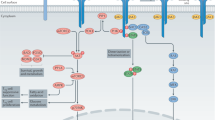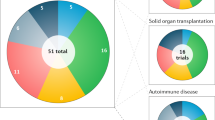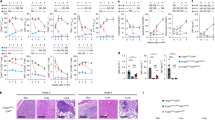Abstract
Regulatory T cells (TREG) are a subset of CD4+ T cells with a critical role in the prevention of autoimmunity. Whether defects in TREG contribute to the pathogenesis of rheumatoid arthritis (RA) is unclear. However, a variety of approved and experimental drugs for RA may work, in part, by promoting the function or increasing numbers of TREG. Furthermore, animal studies demonstrate that direct injection of TREG ameliorates a wide range of experimental models of inflammatory and autoimmune diseases. Thus, cell-based therapy with TREG has the potential to produce durable disease remission in patients with RA.
Key Points
-
FOXP3+ regulatory T cells (TREG) control autoimmunity in humans
-
Some evidence suggests that patients with rheumatoid arthritis have defects in TREG, but whether these defects are the cause or result of chronic inflammation is not clear
-
Several approved and experimental drugs promote function or increase numbers of TREG, and these effects may be responsible for these drugs' efficacy in treating RA
-
Cellular therapy with autologous ex vivo expanded TREG may prove effective as a treatment for patients with RA
This is a preview of subscription content, access via your institution
Access options
Subscribe to this journal
Receive 12 print issues and online access
$209.00 per year
only $17.42 per issue
Buy this article
- Purchase on Springer Link
- Instant access to full article PDF
Prices may be subject to local taxes which are calculated during checkout

Similar content being viewed by others
References
Tang, Q. & Bluestone, J. A. Regulatory T-cell physiology and application to treat autoimmunity. Immunol. Rev. 212, 217–237 (2006).
Liu, W. et al. CD127 expression inversely correlates with FOXP3 and suppressive function of human CD4+ TREG cells. J. Exp. Med. 203, 1701–1711 (2006).
Putnam, A. L. et al. Expansion of human regulatory T-cells from patients with type 1 diabetes. Diabetes 58, 652–662 (2009).
Shevach, E. M. Mechanisms of Foxp3+ T regulatory cell-mediated suppression. Immunity 30, 636–645 (2009).
Andre, S., Tough, D. F., Lacroix-Desmazes, S., Kaveri, S. V. & Bayry, J. Surveillance of antigen-presenting cells by CD4+ CD25+ regulatory T cells in autoimmunity: immunopathogenesis and therapeutic implications. Am. J. Pathol. 174, 1575–1587 (2009).
Hsieh, C. S. et al. Recognition of the peripheral self by naturally arising CD25+ CD4+ T cell receptors. Immunity 21, 267–277 (2004).
Fontenot, J. D., Gavin, M. A. & Rudensky, A. Y. Foxp3 programs the development and function of CD4+CD25+ regulatory T cells. Nat. Immunol. 4, 330–336 (2003).
Bacchetta, R. et al. Defective regulatory and effector T cell functions in patients with FOXP3 mutations. J. Clin. Invest. 116, 1713–1722 (2006).
Wildin, R. S. et al. X-linked neonatal diabetes mellitus, enteropathy and endocrinopathy syndrome is the human equivalent of mouse scurfy. Nat. Genet. 27, 18–20 (2001).
Mazzolari, E. et al. A new case of IPEX receiving bone marrow transplantation. Bone Marrow Transplant. 35, 1033–1034 (2005).
Dorsey, M. J., Petrovic, A., Morrow, M. R., Dishaw, L. J. & Sleasman, J. W. FOXP3 expression following bone marrow transplantation for IPEX syndrome after reduced-intensity conditioning. Immunol. Res. 44, 179–184 (2009).
Baud, O. et al. Treatment of the immune dysregulation, polyendocrinopathy, enteropathy, X-linked syndrome (IPEX) by allogeneic bone marrow transplantation. N. Engl. J. Med. 344, 1758–1762 (2001).
Rao, A. et al. Successful bone marrow transplantation for IPEX syndrome after reduced-intensity conditioning. Blood 109, 383–385 (2007).
Seidel, M. G. et al. Selective engraftment of donor CD4+25high FOXP3-positive T cells in IPEX syndrome after nonmyeloablative hematopoietic stem cell transplantation. Blood 113, 5689–5691 (2009).
Wang, J., Wicker, L. S. & Santamaria, P. IL-2 and its high-affinity receptor: genetic control of immunoregulation and autoimmunity. Semin. Immunol. doi:10.1016/j.smim.2009.04.004.
Tran, D. Q., Ramsey, H. & Shevach, E. M. Induction of FOXP3 expression in naive human CD4+FOXP3 T cells by T-cell receptor stimulation is transforming growth factor-β dependent but does not confer a regulatory phenotype. Blood 110, 2983–2990 (2007).
Miyara, M. et al. Functional delineation and differentiation dynamics of human CD4+ T cells expressing the FOXP3 transcription factor. Immunity 30, 899–911 (2009).
Floess, S. et al. Epigenetic control of the FOXP3 locus in regulatory T cells. PLoS Biol. 5, e38 (2007).
Zhou, L., Chong, M. M. & Littman, D. R. Plasticity of CD4+ T cell lineage differentiation. Immunity 30, 646–655 (2009).
Wieczorek, G. et al. Quantitative DNA methylation analysis of FOXP3 as a new method for counting regulatory T cells in peripheral blood and solid tissue. Cancer Res. 69, 599–608 (2009).
Brusko, T. M., Putnam, A. L. & Bluestone, J. A. Human regulatory T cells: role in autoimmune disease and therapeutic opportunities. Immunol. Rev. 223, 371–390 (2008).
Baecher-Allan, C., Brown, J. A., Freeman, G. J. & Hafler, D. A. CD4+CD25high regulatory cells in human peripheral blood. J. Immunol. 167, 1245–1253 (2001).
Michel, L. et al. Patients with relapsing–remitting multiple sclerosis have normal TREG function when cells expressing IL-7 receptor α-chain are excluded from the analysis. J. Clin. Invest. 118, 3411–3419 (2008).
van Amelsfort, J. M., Jacobs, K. M., Bijlsma, J. W., Lafeber, F. P. & Taams, L. S. CD4+CD25+ regulatory T cells in rheumatoid arthritis: differences in the presence, phenotype, and function between peripheral blood and synovial fluid. Arthritis Rheum. 50, 2775–2785 (2004).
Ehrenstein, M. R. et al. Compromised function of regulatory T cells in rheumatoid arthritis and reversal by anti-TNF-α therapy. J. Exp. Med. 200, 277–285 (2004).
Mottonen, M. et al. CD4+ CD25+ T cells with the phenotypic and functional characteristics of regulatory T cells are enriched in the synovial fluid of patients with rheumatoid arthritis. Clin. Exp. Immunol. 140, 360–367 (2005).
Flores-Borja, F., Jury, E. C., Mauri, C. & Ehrenstein, M. R. Defects in CTLA-4 are associated with abnormal regulatory T cell function in rheumatoid arthritis. Proc. Natl Acad. Sci. USA 105, 19396–19401 (2008).
Cao, D. et al. Isolation and functional characterization of regulatory CD25brightCD4+ T cells from the target organ of patients with rheumatoid arthritis. Eur. J. Immunol. 33, 215–223 (2003).
Lawson, C. A. et al. Early rheumatoid arthritis is associated with a deficit in the CD4+CD25high regulatory T cell population in peripheral blood. Rheumatology (Oxford) 45, 1210–1217 (2006).
Lazarski, C. A., Hughson, A., Sojka, D. K. & Fowell, D. J. Regulating TREG cells at sites of inflammation. Immunity 29, 511–512 (2008).
Tang, Q. et al. Central role of defective interleukin-2 production in the triggering of islet autoimmune destruction. Immunity 28, 687–697 (2008).
Valencia, X. et al. TNF downmodulates the function of human CD4+CD25hi T-regulatory cells. Blood 108, 253–261 (2006).
Schneider, A. et al. The effector T cells of diabetic subjects are resistant to regulation via CD4+ FOXP3+ regulatory T cells. J. Immunol. 181, 7350–7355 (2008).
Nadkarni, S., Mauri, C. & Ehrenstein, M. R. Anti-TNF-α therapy induces a distinct regulatory T cell population in patients with rheumatoid arthritis via TGF-β. J. Exp. Med. 204, 33–39 (2007).
Emery, P. et al. IL-6 receptor inhibition with tocilizumab improves treatment outcomes in patients with rheumatoid arthritis refractory to anti-tumour necrosis factor biologicals: results from a 24-week multicentre randomised placebo-controlled trial. Ann. Rheum. Dis. 67, 1516–1523 (2008).
Maini, R. N. et al. Double-blind randomized controlled clinical trial of the interleukin-6 receptor antagonist, tocilizumab, in European patients with rheumatoid arthritis who had an incomplete response to methotrexate. Arthritis Rheum. 54, 2817–2829 (2006).
Jones, G. et al. Comparison of tocilizumab monotherapy versus methotrexate monotherapy in patients with moderate to severe rheumatoid arthritis: the AMBITION study. Ann. Rheum. Dis. doi:ard.2008.105197v1.
Genovese, M. C. et al. Interleukin-6 receptor inhibition with tocilizumab reduces disease activity in rheumatoid arthritis with inadequate response to disease-modifying antirheumatic drugs: the tocilizumab in combination with traditional disease-modifying antirheumatic drug therapy study. Arthritis Rheum. 58, 2968–2980 (2008).
Pasare, C. & Medzhitov, R. Toll pathway-dependent blockade of CD4+CD25+ T cell-mediated suppression by dendritic cells. Science 299, 1033–1036 (2003).
Chen, X. et al. Blockade of interleukin-6 signaling augments regulatory T cell reconstitution and attenuates the severity of graft versus host disease. Blood 114, 891–900 (2009).
Yang, L. et al. IL-21 and TGF-β are required for differentiation of human TH17 cells. Nature 454, 350–352 (2008).
Dominitzki, S. et al. Cutting edge: trans-signaling via the soluble IL-6R abrogates the induction of FoxP3 in naive CD4+CD25 T cells. J. Immunol. 179, 2041–2045 (2007).
Acosta-Rodriguez, E. V., Napolitani, G., Lanzavecchia, A. & Sallusto, F. Interleukins 1β and 6 but not transforming growth factor-β are essential for the differentiation of interleukin 17-producing human T helper cells. Nat. Immunol. 8, 942–949 (2007).
van Amelsfort, J. M. et al. Proinflammatory mediator-induced reversal of CD4+, CD25+ regulatory T cell-mediated suppression in rheumatoid arthritis. Arthritis Rheum. 56, 732–742 (2007).
Linsley, P. S. & Nadler, S. G. The clinical utility of inhibiting CD28-mediated costimulation. Immunol. Rev. 229, 307–321 (2009).
Bluestone, J. A. et al. The effect of costimulatory and interleukin 2 receptor blockade on regulatory T cells in renal transplantation. Am. J. Transplant. 8, 2086–2096 (2008).
Tang, Q. et al. Cutting edge: CD28 controls peripheral homeostasis of CD4+CD25+ regulatory T cells. J. Immunol. 171, 3348–3352 (2003).
Genovese, M. C. et al. Efficacy and safety of the selective co-stimulation modulator abatacept following 2 years of treatment in patients with rheumatoid arthritis and an inadequate response to anti-tumour necrosis factor therapy. Ann. Rheum. Dis. 67, 547–554 (2008).
Genovese, M. C. et al. Abatacept for rheumatoid arthritis refractory to tumor necrosis factor α inhibition. N. Engl. J. Med. 353, 1114–1123 (2005).
Thomson, A. W., Turnquist, H. R. & Raimondi, G. Immunoregulatory functions of mTOR inhibition. Nat. Rev. Immunol. 9, 324–337 (2009).
Battaglia, M. et al. Rapamycin promotes expansion of functional CD4+CD25+FOXP3+ regulatory T cells of both healthy subjects and type 1 diabetic patients. J. Immunol. 177, 8338–8347 (2006).
Strauss, L., Czystowska, M., Szajnik, M., Mandapathil, M. & Whiteside, T. L. Differential responses of human regulatory T cells (TREG) and effector T cells to rapamycin. PLoS One 4, e5994 (2009).
Iwasaki, A. & Medzhitov, R. Toll-like receptor control of the adaptive immune responses. Nat. Immunol. 5, 987–995 (2004).
Conroy, H., Marshall, N. A. & Mills, K. H. TLR ligand suppression or enhancement of TREG cells? A double-edged sword in immunity to tumours. Oncogene 27, 168–180 (2008).
van Maren, W. W., Jacobs, J. F., de Vries, I. J., Nierkens, S. & Adema, G. J. Toll-like receptor signalling on TREGs: to suppress or not to suppress? Immunology 124, 445–452 (2008).
Hall, J. A. et al. Commensal DNA limits regulatory T cell conversion and is a natural adjuvant of intestinal immune responses. Immunity 29, 637–649 (2008).
Brentano, F., Schorr, O., Gay, R. E., Gay, S. & Kyburz, D. RNA released from necrotic synovial fluid cells activates rheumatoid arthritis synovial fibroblasts via Toll-like receptor 3. Arthritis Rheum. 52, 2656–2665 (2005).
Kyburz, D., Brentano, F. & Gay, S. Mode of action of hydroxychloroquine in RA—evidence of an inhibitory effect on Toll-like receptor signaling. Nat. Clin. Pract. Rheumatol. 2, 458–459 (2006).
Barrat, F. J., Meeker, T., Chan, J. H., Guiducci, C. & Coffman, R. L. Treatment of lupus-prone mice with a dual inhibitor of TLR7 and TLR9 leads to reduction of autoantibody production and amelioration of disease symptoms. Eur. J. Immunol. 37, 3582–3586 (2007).
Tao, R. et al. Deacetylase inhibition promotes the generation and function of regulatory T cells. Nat. Med. 13, 1299–1307 (2007).
Lucas, J. L. et al. Induction of Foxp3+ regulatory T cells with histone deacetylase inhibitors. Cell. Immunol. 257, 97–104 (2009).
Koenen, H. J. et al. Human CD25highFOXP3+ regulatory T cells differentiate into IL-17-producing cells. Blood 112, 2340–2352 (2008).
Mann, B. S., Johnson, J. R., Cohen, M. H., Justice, R. & Pazdur, R. FDA approval summary: vorinostat for treatment of advanced primary cutaneous T-cell lymphoma. Oncologist 12, 1247–1252 (2007).
Setoguchi, R., Hori, S., Takahashi, T. & Sakaguchi, S. Homeostatic maintenance of natural Foxp3+ CD25+ CD4+ regulatory T cells by interleukin (IL)-2 and induction of autoimmune disease by IL-2 neutralization. J. Exp. Med. 201, 723–735 (2005).
Webster, K. E. et al. In vivo expansion of TREG cells with IL-2-mAb complexes: induction of resistance to EAE and long-term acceptance of islet allografts without immunosuppression. J. Exp. Med. 206, 751–760 (2009).
Wei, S. et al. Interleukin-2 administration alters the CD4+FOXP3+ T-cell pool and tumor trafficking in patients with ovarian carcinoma. Cancer Res. 67, 7487–7494 (2007).
Verburg, R. J. et al. High-dose chemotherapy and autologous hematopoietic stem cell transplantation in patients with rheumatoid arthritis: results of an open study to assess feasibility, safety, and efficacy. Arthritis Rheum. 44, 754–760 (2001).
Teng, Y. K. et al. Long-term followup of health status in patients with severe rheumatoid arthritis after high-dose chemotherapy followed by autologous hematopoietic stem cell transplantation. Arthritis Rheum. 52, 2272–2276 (2005).
Snowden, J. A. et al. Autologous hemopoietic stem cell transplantation in severe rheumatoid arthritis: a report from the EBMT and ABMTR. J. Rheumatol. 31, 482–488 (2004).
De Kleer, I. M. et al. Autologous stem cell transplantation for refractory juvenile idiopathic arthritis: analysis of clinical effects, mortality, and transplant related morbidity. Ann. Rheum. Dis. 63, 1318–1326 (2004).
Brinkman, D. M. et al. Autologous stem cell transplantation in children with severe progressive systemic or polyarticular juvenile idiopathic arthritis: long-term follow-up of a prospective clinical trial. Arthritis Rheum. 56, 2410–2421 (2007).
Snowden, J. A., Kapoor, S. & Wilson, A. G. Stem cell transplantation in rheumatoid arthritis. Autoimmunity 1, doi:10.1080/08916930802198550.
Komatsu, N. & Hori, S. Full restoration of peripheral Foxp3+ regulatory T cell pool by radioresistant host cells in scurfy bone marrow chimeras. Proc. Natl Acad. Sci. USA 104, 8959–8964 (2007).
Brusko, T. & Bluestone, J. Clinical application of regulatory T cells for treatment of type 1 diabetes and transplantation. Eur. J. Immunol. 38, 931–934 (2008).
Peters, J. H. et al. Clinical grade TREG: GMP isolation, improvement of purity by CD127 depletion, TREG expansion, and TREG cryopreservation. PLoS ONE 3, e3161 (2008).
Masteller, E. L. et al. Expansion of functional endogenous antigen-specific CD4+CD25+ regulatory T cells from nonobese diabetic mice. J. Immunol. 175, 3053–3059 (2005).
Tang, Q. et al. In vitro-expanded antigen-specific regulatory T cells suppress autoimmune diabetes. J. Exp. Med. 199, 1455–1465 (2004).
Scalapino, K. J., Tang, Q., Bluestone, J. A., Bonyhadi, M. L. & Daikh, D. I. Suppression of disease in New Zealand Black/New Zealand White lupus-prone mice by adoptive transfer of ex vivo expanded regulatory T cells. J. Immunol. 177, 1451–1459 (2006).
Kohm, A. P., Carpentier, P. A., Anger, H. A. & Miller, S. D. Cutting edge: CD4+CD25+ regulatory T cells suppress antigen-specific autoreactive immune responses and central nervous system inflammation during active experimental autoimmune encephalomyelitis. J. Immunol. 169, 4712–4716 (2002).
Mottet, C., Uhlig, H. H. & Powrie, F. Cutting edge: cure of colitis by CD4+CD25+ regulatory T cells. J. Immunol. 170, 3939–3943 (2003).
Morgan, R. A. et al. Cancer regression in patients after transfer of genetically engineered lymphocytes. Science 314, 126–129 (2006).
Arbour, N. et al. A new clinically relevant approach to expand myelin specific T cells. J. Immunol. Meth. 310, 53–61 (2006).
Beriou, G. et al. IL-17-producing human peripheral regulatory T cells retain suppressive function. Blood 113, 4240–4249 (2009).
Voo, K. S. et al. Identification of IL-17-producing FOXP3+ regulatory T cells in humans. Proc. Natl Acad. Sci. USA 106, 4793–4798 (2009).
Zhou, X. et al. Instability of the transcription factor Foxp3 leads to the generation of pathogenic memory T cells in vivo. Nat. Immunol. doi: 10.1038/ni.1774.
Annunziato, F. et al. Phenotypic and functional features of human TH17 cells. J. Exp. Med. 204, 1849–1861 (2007).
Evans, H. G., Suddason, T., Jackson, I., Taams, L. S. & Lord, G. M. Optimal induction of T helper 17 cells in humans requires T cell receptor ligation in the context of Toll-like receptor-activated monocytes. Proc. Natl Acad. Sci. USA 104, 17034–17039 (2007).
Riley, J. L., June, C. H. & Blazar, B. R. Human T regulatory cell therapy: take a billion or so and call me in the morning. Immunity 30, 656–665 (2009).
Umbilical cord blood T-regulatory cell infusion followed by donor umbilical cord blood transplant in treating patients with high-risk leukemia or other hematologic diseases. ClinicalTrials.gov [online] (2009).
Acknowledgements
The authors thank Todd Brusko and Amy Putnam for helpful discussions and for assistance with figure design.
Author information
Authors and Affiliations
Corresponding author
Ethics declarations
Competing interests
J. H. Esensten and D. Wofsy declare no competing interests. J. A. Bluestone has applied for a U.S. patent (“CD127 Expression Inversely Correlates with FoxP3 and Suppressive Function of CD4+ Tregs”, application number 20080131445) for a method of identifying of Tregs using CD127.
Rights and permissions
About this article
Cite this article
Esensten, J., Wofsy, D. & Bluestone, J. Regulatory T cells as therapeutic targets in rheumatoid arthritis. Nat Rev Rheumatol 5, 560–565 (2009). https://doi.org/10.1038/nrrheum.2009.183
Issue Date:
DOI: https://doi.org/10.1038/nrrheum.2009.183
This article is cited by
-
Disease-microenvironment modulation by bare- or engineered-exosome for rheumatoid arthritis treatment
Biomaterials Research (2023)
-
Ceria-vesicle nanohybrid therapeutic for modulation of innate and adaptive immunity in a collagen-induced arthritis model
Nature Nanotechnology (2023)
-
Efficacy and safety of low-dose interleukin-2 in combination with methotrexate in patients with active rheumatoid arthritis: a randomized, double-blind, placebo-controlled phase 2 trial
Signal Transduction and Targeted Therapy (2022)
-
Programmed cell death 5 transgenic mice attenuates adjuvant induced arthritis by 2 modifying the T lymphocytes balance
Biological Research (2017)
-
Therapeutic effect of a novel histone deacetylase 6 inhibitor, CKD-L, on collagen-induced arthritis in vivo and regulatory T cells in rheumatoid arthritis in vitro
Arthritis Research & Therapy (2017)



